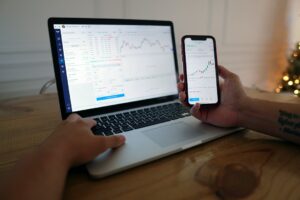Risk management is a crucial aspect of any form of trading, whether in the stock market or the forex market. It is the key to minimizing losses and protecting your capital. In this article, we will compare risk management strategies in stock trading and forex trading, and discuss how you can minimize your losses in both markets.
Firstly, let’s understand the fundamental difference between stock trading and forex trading. Stock trading involves buying and selling shares of individual companies listed on stock exchanges. On the other hand, forex trading involves trading currencies in the global foreign exchange market. The main distinction between the two is the level of volatility and liquidity.
Forex trading is known for its high volatility and liquidity. The forex market is open 24 hours a day, five days a week, and trades around $6 trillion worth of currencies daily. This high liquidity provides ample opportunities for traders to enter and exit trades quickly. However, it also means that the market can be highly unpredictable, leading to potential losses if not managed properly.
Stock trading, on the other hand, is generally less volatile and less liquid compared to forex trading. The stock market operates within specific trading hours and is influenced by company-specific news and events. While it may be less volatile, individual stocks can still experience significant price movements, especially during earnings releases or major announcements.
Now that we’ve established the differences between stock trading and forex trading, let’s discuss risk management strategies that can be applied to both.
1. Set a Stop Loss: A stop-loss order is an essential risk management tool that allows traders to specify the maximum amount of money they are willing to lose on a trade. By setting a stop loss, you can limit your losses and protect your capital. It is crucial to determine an appropriate stop loss level based on your risk tolerance and the market conditions.
2. Use Proper Position Sizing: Position sizing refers to the amount of capital allocated to each trade. It is important to determine the appropriate position size based on your account size, risk tolerance, and the potential risk/reward ratio of the trade. By using proper position sizing techniques, you can ensure that your losses are limited to a predefined percentage of your capital.
3. Diversify Your Portfolio: Diversification is the act of spreading your investments across different assets or markets. By diversifying your portfolio, you can reduce the impact of a single trade or investment on your overall portfolio. In stock trading, this can be achieved by investing in different sectors or industries. In forex trading, diversification can be achieved by trading different currency pairs or by incorporating other asset classes, such as commodities or indices.
4. Stay Informed and Use Fundamental Analysis: Staying informed about the latest news and events that can impact the markets is crucial for effective risk management. In stock trading, it is essential to analyze the fundamentals of the companies you are investing in. In forex trading, understanding the economic factors that drive currency movements is key. By using fundamental analysis, you can make more informed decisions and reduce the risk of unexpected market movements.
5. Practice Risk-Reward Ratio: The risk-reward ratio is a measure of the potential profit compared to the potential loss on a trade. It is important to analyze the risk-reward ratio before entering a trade. A favorable risk-reward ratio ensures that the potential reward outweighs the potential risk, providing a higher probability of profitable trades.
In conclusion, risk management is a vital aspect of both stock trading and forex trading. While the level of volatility and liquidity differs between the two markets, the principles of risk management remain the same. By setting a stop loss, using proper position sizing, diversifying your portfolio, staying informed, and practicing risk-reward ratio, you can minimize your losses and protect your capital in both stock trading and forex trading.





